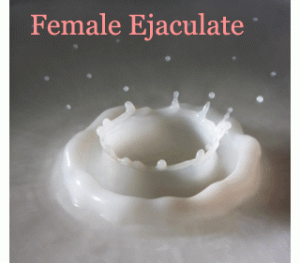The Mystery of Female Ejaculate
We are all pretty used to male ejaculate (aka “cum”). Female ejaculate, however, is another story. Men see their own on a regular basis, at the moment of orgasm or on their partner’s body after sex or a sock/towel after masturbation.
Women often see male ejaculate during oral sex or somewhere on their body or sheets after sex. And we all see it in almost any scene in adult movies, commonly called the ‘money shot’ because an adult film does not make money without it. There is even a genre dedicated to men showing off their life-giving liquid to one central lady who is happily lapping it up – called bukkake.
In other words, male ejaculate is a known, vital and lively substance.
Women’s (female ejaculate), on the other hand, is a much more debated substance. Some say it is made up of urine, others say it is made of prostatic fluid (just like men’s ejaculate minus the semen) and still others say it doesn’t even exist.
Female Ejaculate: Urine or not urine?
Squirting, or female ejaculation, is the expulsion of an amount of fluid during sexual arousal. There has been much debate over whether the fluid that spurts or seeps out of the urethral opening is actually urine. Analysis of the thicker ejaculate has found only small traces of urine in the fluid (similar to what is found in male ejaculate), in quantities that make sense if it were picking it up as it moves through the lower portion of the urethra.
More reasons we know female ejaculate is not urine.
- The practical test: it does not look or smell like urine.
- Extensive analysis of the liquid shows it to be dissimilar to urine.
- Women who ejaculate tend to have strong PC muscles and no sign of incontinence in their regular lives. In other words there is no reason for ejaculating women to be urinating during orgasm.
So, what is female ejaculate made of then?
Many studies (starting in 1981), show the biochemical makeup of female ejaculate to have a the major components of male ejaculate (without the sperm) including:
- High concentration of prostate specific antigen (PSA)
- Prostatic acidic phosphate (PAP)
- Prostate specific acid phosphatase (PSAP)
- Glucose
It has been suggested that there are two types of ejaculate. One is thinner in consistency and associated with the more voluminous “gushing” or “squirting.” And the other, a thicker, whiter fluid that is associated with the less obvious “seeping” or “eking.” With the latter mimicking male prostatic fluid.
These two may be different in their makeup, with the latter being considered ‘female ejaculate’. Recent studies (Pastor et al., 2022) separates these two types of “ejaculation” by where they come from and what they are made of. A new study suggests that the “squirting” style of female ejaculation does come from the bladder and contains some components of urine.
“At present, SQ (squirting) is considered as a transurethral expulsion of approximately 10 milliliters or more of transparent fluid, while FE (female ejaculation) is considered as a secretion of a few milliliters of thick fluid. The fluid in SQ is similar to urine and is expelled by the urinary bladder. The secretion in FE originates from the paraurethral glands and contains a high concentration of prostate-specific antigen.”
The jury is still out on the relevance of these studies with small samples (eg. only 7 women), and the push back from many women who say their experience of squirting does not match up with this explanation. In other words, we need more data.
But, are we asking the right question?
Whether female ejaculate is chemically made up of the components of urine or not, is not the right question. A better question would be, what do people ‘experience’ with female ejaculation? Anecdotal evidence from women who “squirt,” and the men who are with women who squirt, still say that the fluid does not smell or look like urine. One lesbian sex therapist who squirts told us, “it smells and tastes like a woman, not urine. Isn’t that what is important?”
Many women ejaculate. Do we really want women to stop enjoying their pleasurable experiences such as orgasms because they are afraid it might contain some pee? We don’t seem to have the same concern with men’s ejaculate.
Many women already have trouble reaching orgasm. Let’s not add another self-conscious concern to the list.
Why do women ejaculate?
One theory is that female ejaculate may have anti-bacterial and anti-fungal properties. Substances that are found in female ejaculate, such as zinc, are known to help guard the delicate genital tissues against infection.
What does female ejaculate look like?
The fluid that is ejaculated is clear or white, that looks quite different urine. For some it has been compared to fat-free milk in consistency, while for others describe it as thicker and white.
What does female ejaculate smell and taste like?
The fluid that is ejaculated has little smell or taste. A while it may have a faint smell of urine, that is because it comes travels in the same place as urine. But, in general female ejaculate neither tastes nor smells like urine. It does taste and smell different for each woman, in different times of her cycle and what she has been eating or drinking.
Foods that affect the taste and smell of female ejaculate:
- coffee
- asparagus
- alcohol
- chocolate
* if you are worried about the taste and smell of your ejaculate keep well hydrated to dilute any concentrated smells.
How much volume is there in an ejaculation?
Female ejaculators come in two quite different groups, one that ejaculates large amounts (1 c.), “gushers” or “squirters,” and others that “eke” out small amounts (1 teaspoon) of usually thicker liquid.
There is a growing number of men who are pressuring their partner to female ejaculate
A recent phenomenon has women reporting male lovers pressuring them to ejaculate. This is another type of pressure that many women find problematic and may be due to the growing popularity of female ejaculation portrayed in pornography. There are two points to consider here; 1. while g-spot stimulation is associated with the female ejaculation, it is so for only some women, and does not result in ejaculation in the majority of women (approximately only 40% have reported some kind of ejaculation). And, 2. the motivation to ejaculate is different for men and women. Female ejaculation is not linked to orgasm in the same way that men’s ejaculation is linked to men’s orgasm. Many women who ejaculate report it feels more like a “release,” but it is not necessarily associated with the ‘pleasure’ of orgasm. The motivation for a woman to ejaculate may, therefore, be her lover’s ego, rather than her pleasure. (Påfs, 2021)
Female ejaculation is a wondrous experience for some women, but it is not for every woman. This pressure may take away a woman’s pleasure by adding a performance pressure or making her feel inadequate for not being able to do something she may not want to do or even find pleasurable.
Physical factors that can influence the volume and makeup of female ejaculate:
- stage of the menstrual cycle
- hormonal levels
- age
- hydration
- strength of the PC muscles
- anatomical tendency toward retrograde ejaculation (into the bladder)
Psychological factors that can influence the volume and makeup of female ejaculate:
- comfort with partner or sexual scenario
- level of ability to “let go” in the situation
- habit of holding back
- type of stimulation (g-spot or clitoral)
- level of arousal
Female ejaculate is a magical liquid that can encourage pleasure and excitement in many woman’s sex lives.
Now, I can only imagine a new genre in adult film – fem-bukkake – where several women encircle and ejaculate on a central man, as he laps up every bit!
More about female ejaculation:
– Anatomy of female ejaculation
– Tools to get started with female ejaculation
– Recommended book: Female Ejaculation and the G-Spot
More references:
Darling CA, Davidson JK and Conway-Welch C (1990) Female ejaculation: perceived origins, the Grafenberg spot/area, and sexual responsiveness. Archives of Sexual Behavior 19(1): 29–47.
Inoue, M., Sekiguchi, Y., Ninomiya, N., Kobayashi, T., & Araki, M. (2022). Enhanced visualization of female squirting. International Journal of Urology, 29(11), 1368-1370.
Påfs, J. (2021). A sexual superpower or a shame? Women’s diverging experiences of squirting/female ejaculation in Sweden. Sexualities, 13634607211041095.
Pastor, Z., & Chmel, R. (2022). Female ejaculation and squirting as similar but completely different phenomena: A narrative review of current research. Clinical Anatomy, 35(5), 616-625.
Rodriguez, F. D., Camacho, A., Bordes, S. J., Gardner, B., Levin, R. J., & Tubbs, R. S. (2021). Female ejaculation: An update on anatomy, history, and controversies. Clinical Anatomy, 34(1), 103-107.
Salama, S., Boitrelle, F., Gauquelin, A., Malagrida, L., Thiounn, N., & Desvaux, P. (2015). Nature and origin of “squirting” in female sexuality. The journal of sexual medicine, 12(3), 661-666.


 Follow
Follow